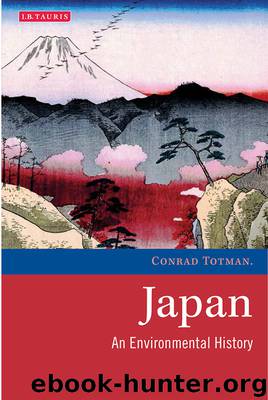Japan by Totman Conrad;

Author:Totman, Conrad;
Language: eng
Format: epub
Publisher: I. B. Tauris & Company, Limited
By Illegal Felling
1,826,783
By Natural Causes
2,010,957
Thus natural damage – mostly due to high winds, heavy snowfall or lightning strikes – ruined less than a third as many trees as did humanly caused injury. By far the worst damage was wrought by arson, which villagers employed to clear land for other uses or simply to render it so worthless as timberland that the government would turn it over to villagers as private or communal land. And they engaged in illicit felling so as to obtain timber or fuel wood, or to devalue the land and thereby induce government to reassign it to local people.
Even as these push and pull factors were causing the woodland situation to deteriorate at an alarming rate, Meiji leaders were launching other forest-related initiatives, and these included the study of European forestry. The investigators discovered, however, that – in contrast to medicine, mining, transport and many other technical fields – the “best practices” of Japan’s existing silviculture were, in their day-to-day techniques, largely appropriate to the new age.
Nevertheless, the study of European forestry (German forestry in particular, because it was Europe’s most advanced) provided two valuable lessons. First, Japan’s existing silvicultural practices were “scientific” and therefore up-to-date and worthy of promotion. Second, the government could properly take a leading role in woodland rehabilitation so as to maximize the public good. By 1890 this “new” perspective on woodland management was becoming well established, in the process perpetuating or refining most of the silvicultural techniques that had emerged during the two preceding centuries. Thus revitalized, those techniques were vigorously applied and, as we shall see in Chapter 7, over the next few decades they gradually reversed much of the earlier woodland damage, leading to extensive rehabilitation of Japan’s forest land.
Fisheries
Fishing has a long history in Japan. It was a part of forager culture and continued to function as a forager-type enterprise thereafter, until around 1700 when the first signs of “agricultural” fisheries appeared.92
During the centuries of early agriculture, the amount of fishing activity had grown as the population rose. Boats became larger and other fishing equipment – notably hooks, lines and nets – improved. However, two factors constrained that growth. One was the seasonality and unpredictability of the marine fish supply; the other, the irregularity of the market because so much of the fish catch tended to be consumed as a ceremonial dish for holiday feasting or other special occasions.
Gradually, however, fishing communities overcame the market irregularity by learning how to dry or salt fresh fish for storage and shipment. Those techniques also helped them make fuller use of more types of fish and other sea life, including seaweed, shellfish and sea mammals. And with the proliferation of entrepreneurial merchants during medieval centuries, fishermen gained access to a much broader market place.
During the early 1600s, when bakuhan leaders issued regulations to govern the realm, they applied to nearby waters the same ritsuryô-era principle of use rights that they applied to land. So, when coastal communities were surveyed, boundaries were delineated
Download
This site does not store any files on its server. We only index and link to content provided by other sites. Please contact the content providers to delete copyright contents if any and email us, we'll remove relevant links or contents immediately.
| Africa | Americas |
| Arctic & Antarctica | Asia |
| Australia & Oceania | Europe |
| Middle East | Russia |
| United States | World |
| Ancient Civilizations | Military |
| Historical Study & Educational Resources |
The Sympathizer by Viet Thanh Nguyen(4093)
The Rape of Nanking by Iris Chang(4022)
World without end by Ken Follett(3341)
Ants Among Elephants by Sujatha Gidla(3279)
Blood and Sand by Alex Von Tunzelmann(3055)
Japanese Design by Patricia J. Graham(2998)
City of Djinns: a year in Delhi by William Dalrymple(2434)
Foreign Devils on the Silk Road: The Search for the Lost Treasures of Central Asia by Peter Hopkirk(2385)
Inglorious Empire by Shashi Tharoor(2345)
The Queen of Nothing by Holly Black(2313)
In Order to Live: A North Korean Girl's Journey to Freedom by Yeonmi Park(2302)
India's Ancient Past by R.S. Sharma(2293)
Tokyo by Rob Goss(2289)
India's biggest cover-up by Dhar Anuj(2242)
Tokyo Geek's Guide: Manga, Anime, Gaming, Cosplay, Toys, Idols & More - The Ultimate Guide to Japan's Otaku Culture by Simone Gianni(2239)
The Great Game: On Secret Service in High Asia by Peter Hopkirk(2228)
Goodbye Madame Butterfly(2162)
Batik by Rudolf Smend(2007)
Living Silence in Burma by Christina Fink(1977)
